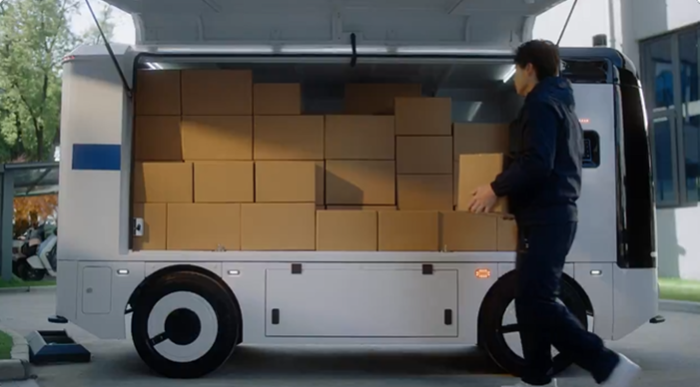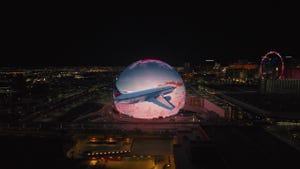Flying Car Rotors Ready for Mass Production
Serial production of the Pal-V is being set up at a small-scale assembly location in the Netherlands

Rotor blades for the flying car Pal-V Liberty have been developed in collaboration with the Royal NLR Netherlands Aerospace Center, bringing the flying vehicle closer to mass production.
The new rotor blades are 20% more efficient with less drag compared to equivalent blades, according to the company.
Serial production of the Pav-V is being set up at a small-scale assembly location in the Netherlands, near the company headquarters.
A set of two rotor blades weighs 78 pounds and spans nearly 36 feet.

Credit: Pal-V
"We are thrilled to have reached another milestone with our new technology for high-end composite rotor blades," said Henri de Vries, senior scientist at NLR. "Together with PAL-V we’ve overcome technical challenges and ensured our rotor blades are ready for industrial production.
“Gyroplane rotor blades are brought in motion by the airflow to create lift instead of by using a motor, this is called autorotation. So the Pal-V blades are basically its wings during flight. Next to being lightweight, they contain a mid-hinge to fold the blades and enable driving the vehicle on the road with a convenient vehicle length.”
To develop and test the Pal-V Liberty, NLR used its state-of-the-art facilities with wind tunnels, composite manufacturing, structure testing equipment and a landing strip.
The Pal-V Liberty recently completed its first Periodic Technical Inspection (PTI), four years after it was certified for road travel.
The PTI is a mandatory inspection for most road vehicles in the Netherlands and is approved by the Netherlands Vehicle Authority. The test checks if the vehicle is roadworthy, environmentally safe and registered correctly.
The rotor development brings the Liberty closer to production for sales.
“Since its existence Pal-V has been the front-runner in the upcoming advanced air mobility market (AAM), outpacing any player due to its focus on using existing regulations,” said Robert Dingemanse, CEO and founder of Pal-V. “With the support of numerous suppliers and esteemed partners like NLR, Pal-V now concentrates on finalizing the last stage of air certification, compliance demonstration. With an orderbook filling the first three years of production by a majority of professional customers, as well as private individuals, the PAL-V Liberty will be used to overcome the growing global mobility challenges.
The Pal-V Liberty received European road certification in 2020, allowing the flying car to be driven on public roads.
The PTI approval in the Netherlands follows four years of driving on European roads.
The Pal-V Liberty is a gyroplane, which has relatively small, fixed wings and a rear propeller that pushes it forward, causing a rotor atop the vehicle to spin.
The vehicle, somewhat of a cross between a helicopter and a plane, requires an airfield to take off and land and is powered by a 200-horsepower engine.
The two-person vehicle has a land range of 800 miles with a maximum speed of 100 mph and a flight range of up to 300 miles at a maximum altitude of 11,000 feet.
The transformation from road driving to flying takes five minutes, according to the company.
The airport in the south of the Netherlands would be the first European airport to host a dedicated Pal-V assembly and delivery center.
Forum Group had developed a strategy to convert the airfield into a mobility innovation hub.
The Pal-V (personal air and land vehicle) Liberty is certified to drive on public roads and expects its aviation certification this year.
The Pal-V Pioneer Edition is powered by e-fuels and hybrid fuel technologies.
The new airport facility would become the Pal-V home for final assembly, customer demonstrations, flight training and pre-delivery inspections.
Pal-V is in the process of completing a funding package with international and Dutch investors.
Customers have been training at Breda International Airport since 2019.
Most reservations have been made for professional use including first responders, policing and border control while the first customers are private individuals filling the first three years of planned production, according to the company.
Earlier this year, Pal-V received an order for 100 of its flying vehicles from Aviterra, a Dubai company that plans to bring the vehicles to the Middle East and Africa.
Customers would be able to drive the vehicles themselves or use Aviterra's services, according to the company.
The 10-year-old Netherlands startup had already opened a showroom dedicated to flying cars in Munich, Germany.
Loggia Investment, the investment arm of Aviterra, is also an investor in Pal-V.
The flying vehicle differs from others coming to market around the world. Those are primarily VTOL (vertical takeoff and landing) vehicles, which do not require a runway since they take off and land vertically, and most are electric.
Pal-V has different versions of its Liberty flying car, including a sport edition and pioneer edition, which is highly personalized.
Retail showrooms for aerial vehicles are already in the works in the U.S. with others on the way.
For example, Aeroauto Global in Royal Palm Beach, Florida, is developing EAV showroom locations in Florida, one in Hollywood and another in Palm Beach Gardens. It is also planning a showroom in Texas at the Greenport International Airport and Technology Center in Emerald Island.
The Pal-V showroom serves as a platform for buyers or investors. The vehicle is expected to cost in the range of $500,000.
Read more about:
Flying CarsAbout the Author
You May Also Like








